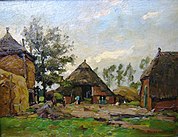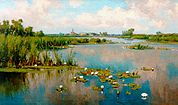Bernardus Antonie van Beek
Bernardus Antonie van Beek (born January 30, 1875 in Amsterdam , † March 3, 1941 in Kortenhoef ) was a Dutch painter . He was an artist who had not attended an academy, is included in the Hague School and is thus in the tradition of the Barbizon School . In terms of his choice of motif, there are also influences from Amsterdam Impressionism .
life and work
At first he worked for his father as a decorative painter. He then attended the School of Arts and Crafts. Then he trained himself further in panel painting.
Van Beek has worked in various places in the north of Holland. First he was in Katwijk aan Zee until 1907 . Then he had a studio in Amsterdam. From 1911 he went to Kortenhoef (Wijdemeren), where he stayed until 1931. Vreeland ( Stichtse Vecht ), where he worked as a painter until his death in 1941, marked the end of his journey .
In Kortenhoef, he met Paul Gabriël , who had a great influence on his early work. He also introduced him to new topics, such as the water lily landscapes in the moor areas, including around Kortenhoef. and the peat work.
There he came across Evert Pieters and Jan Hillebrand Wijsmuller .
These teachers from the Hague School significantly influenced his painting style and the perfection of his education. In his palette, he consciously chose those painting media that produced strong surface light. This followed the tradition of the second generation of the Hague School - even the winter face does not have the usual gloom, but is expressed in the lightening of the chosen color quality - this is a result of the interaction of the painting ground and the colorant with its binding agent. When it comes to the faces of the city, he almost takes up the palette of Jan Vermeer (1632–1675), as seen in “ Straße in Delft ” and Gerrit Adriaenszoon Berckheyde (1638–1698) “The Great Market in Haarlem with the St. Bravo Church” is comparable. His chosen colors are a sensitive modification of the old while retaining the characteristics of the Hague School. The chosen, graduated shade of blue as a message of the captured mood is an important characteristic of his paintings.
The structure of the picture in the form corresponds to that of the old Dutch landscape painting, i.e. rising from the bottom left to the top right. His picture horizon moves from the lower third over the bisector to the upper third.
To the oeuvre
His chosen picture genres extended from the genre to landscape painting with scenes from the summer landscape over the polder landscape to the city face. In terms of art history, it can be assigned to Amsterdam Impressionism . In the still life he had mainly taken on the flower as an object. In addition, he takes up the classic theme of the windmill by Paul Gabriël (1828–1903), Jacob Maris (1837–1899) and Johan Hendrik Weissenbruch (1824–1903), which in the tradition of Jacob van Ruisdael (1629–1682) in 1. The golden age of Dutch painting is here.
His landscape faces from the immediate vicinity of Kortenhoef are best known. He also takes up the fisherman's life. Here he is primarily devoted to the sailing ship as a source of income and thus takes up a new topic that is characteristic of him, inland fishing.
He also immortalized old city districts. - In the 1920s he discovered the bright, light village face. - Here followed the bright color palette of Jan Vermeer and Gerrit Adriaenszoon Berckheyde .
Van Beek died in 1941 at the age of only 66.
Exhibitions
- 1903 Stedelijke internationale tentoonstelling van kunstwerken van levende meesters, Stedelijk Museum , Amsterdam.
- 1907 Stedelijke internationale tentoonstelling van kunstwerken van levende meesters, Stedelijk Museum , Amsterdam.
- 1912 Stedelijke internationale tentoonstelling van kunstwerken van levende meesters, Stedelijk Museum , Amsterdam.
Museums
- Goois Museum, Hilversum
gallery
literature
- Bernt, Walter: The Dutch painters and draftsmen of the 17th century. Volume 1 and Volume 2, Bruckmann Verlag, Munich 1979, ISBN 3-7654-1768-8 .
- Broude, Norma: Impressionism - an International Movement 1860–1920. Dumond Buchverlag, Cologne 1990, ISBN 3-8321-7454-0 .
- Constable, Freda: John Constable, a biography, 1776–1837. Lavenham, Dalton 1975, ISBN 0-900963-54-9 .
- Huizinga, Johan: Dutch Culture of the 17th Century. Beek Verlag, 2007, ISBN 978-3-406-54756-0 .
- Lindemann, Gottfried: The Golden Age of Dutch Art. Belser Verlag, 2000, ISBN 3-7630-2376-3 .
- Müllerschön, Bernd, Maier, Thomas: The painters of the Barbizon school. Ed. Tombe, Stuttgart 2002, ISBN 3-935252-01-3 .
- Noon, Patrick: John Parkers Bonington - On the Pleasure of Painting. Balding + Mansell, 1991, ISBN 0-300-05108-5 .
- Sillevis, John, Kraan, Hans, Dorn, Roland: The Hague School, masterpieces of Dutch painting of the 19th century from the Haags Gemeentemuseum. Exhibition catalog of the Kunsthalle Mannheim. Edition Braus, 1987, ISBN 3-925835-08-3 .
- Slive, Seymore: Jacob van Ruisdael, A Complete Catalog of His Paintings, Drawings and Etchings. Yale University Press, New Haven / London 2001, ISBN 0-300-08972-4 .
- Wheelock, Arthur K .: Jan Vermeer. Harry N. Abrams Inc., Publishers, New York 1984, ISBN 0-8109-1730-0 .
Magazines
- Anonymous, Bernard van Beek, 1875–30 January -1935 . In: De Kunst 27 (1935), p. 14.
- NH Wolf: Groepen-tentoonstelling in Arti: Bern. A. van Beek, Marianne Franken, CM Garms, Harrie Kuyten, H. IJkelenstam. In: De Kunst 33 (1941), pp. 42–43.
- R. Vetter, W. Vetter: Geesje van Calcar, a real Mesdag. Schipluiden 2001, p. 75, passim .
Remarks
- ↑ The Hague School in The Hague and its surroundings is the place of the countercurrent to the classicist painting of the Netherlands and at the same time the central place of the origin of the Dutch movement of impressionism and at the same time the beginning of the 2nd golden age of Dutch painting.
- ↑ In terms of art history, on the other hand, van Beek is part of the second Golden Age of Dutch painting.
- ↑ The first golden age of Dutch painting was in the 17th century at the time of the 7 republics of the Netherlands.
- ^ Paul Joseph Constantin Gabriël (1828–1903) was one of the main representatives of the Hague School of the 1st generation. He became known for his landscape painting, namely scenes from the polder landscape with its windmills and the rural idyll.
- ↑ The water lily, also known as the water lily , was an important theme in landscape painting at that time, which many artists liked to take up, including Constant Artz, Harold Gilmer, Aris Knikker, Claude Monet , Willem Roelofs , Gertrud Staats , Max Waltz and Jan Hillebrand Wijsmuller .
- ↑ what is meant is the hand peat stitch
- ↑ Peat was also called the poor people's fuel and, when dried, had a high calorific value.
- ↑ Evert Pieters (1856–1932) belonged to the second generation of the Hague School. In landscape painting he had turned to the coastal area and the genre surrounding rural life. The latter is in continuation of the tradition of the peasant satires by Jan Steen (1625-1679) of the 17th century and by Albert Neuhuys (1844-1914) of the Hague School of the 1st generation.
- ↑ Jan Hillebrand Wijsmuller (1855–1925) also belonged to the 2nd generation of the Hague School. His pictorial genres encompass almost the entire oeuvre of this movement of Dutch impressionism .
- ↑ This again reflects the ending system of the Barbizon school, where the master had direct contact with his apprentice in nature and was able to continue or perfect his training.
- ↑ Here he is based on the tradition of Jacob van Ruisdael's palette , which has its precursor in particular in the painting “Winter Landscape with Two Windmills” (currently in private ownership).
- ↑ He had also taken up the broad brushstroke of Frans Hals (~ 1580-1666), who was rediscovered in the 19th century. The way of drawing brushstrokes goes back to Johan Barthold Jongkind (1819–1891).
- ↑ An eloquent example of these lines is the horizon rising from the bottom left to the top right behind the rural shed in the painting “Landscape with a Fountain” by Nicolaes Berchem (1620–1683), formerly Galerie Lichtenstein.
- ↑ In Dutch landscape painting of the 17th century, the line of the lower third was usually chosen for the picture horizon. The best example is “Evening Landscape with a Hamlet on the Maas Island” by Aert van der Neer (1603-1677), currently on view in the Hermitage (Saint Petersburg) .
- ↑ The Hague School had replaced the still life as well as other types of painting. The pictorial genre of the still life, especially the flower, is an old subject of the 17th century that was taken up again by Amsterdam Impressionism .
- ↑ It is in complete contrast to the coast and seascapes of the fishing motifs of Noordwijk , Katwijk and Scheveningen by Bernard Blommers (1845–1914) and Hendrik Willem Mesdag (1831–1951).
| personal data | |
|---|---|
| SURNAME | Beek, Bernardus Antonie van |
| BRIEF DESCRIPTION | Dutch painter |
| DATE OF BIRTH | January 30, 1875 |
| PLACE OF BIRTH | Amsterdam |
| DATE OF DEATH | March 3, 1941 |
| Place of death | Kortenhoef |









